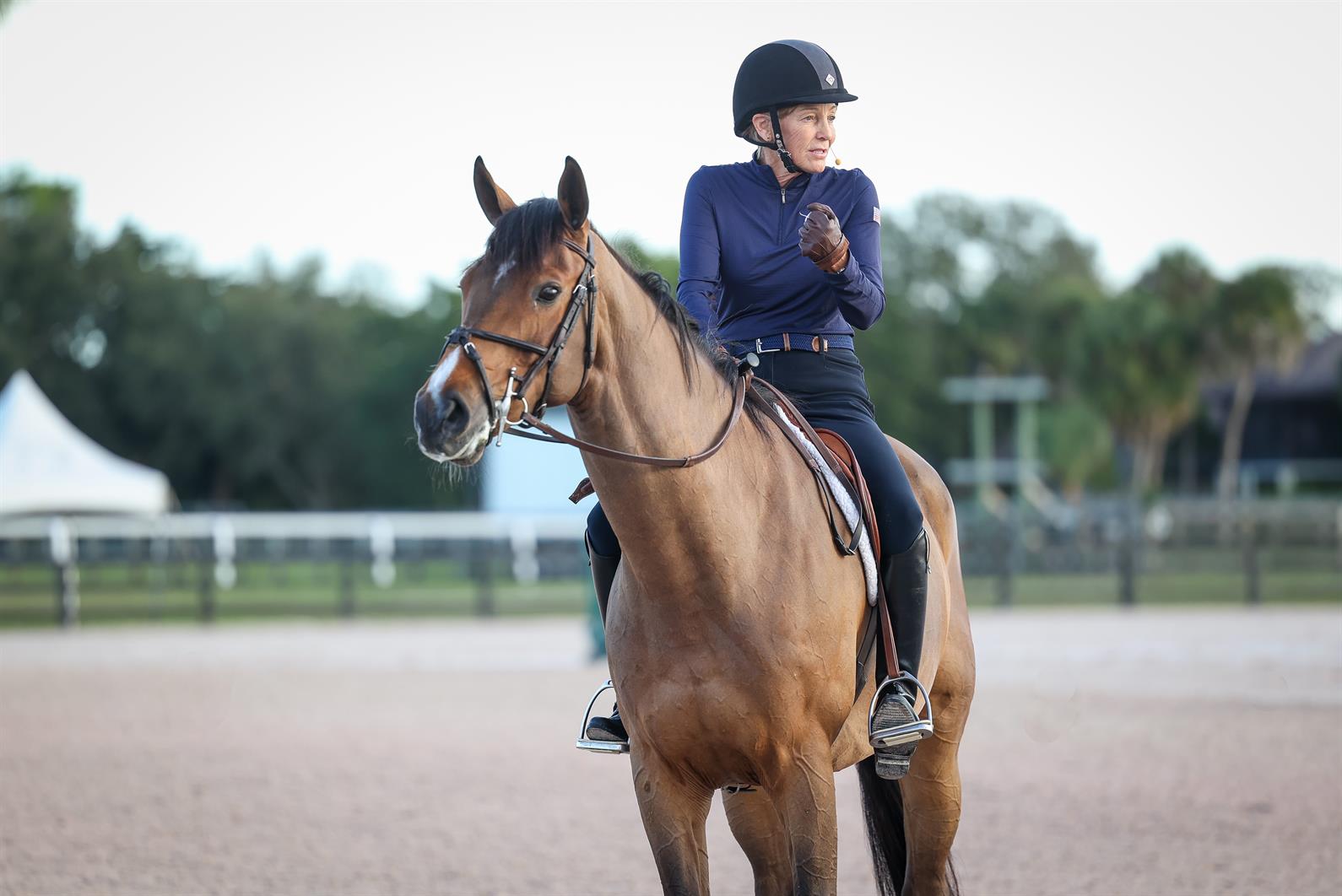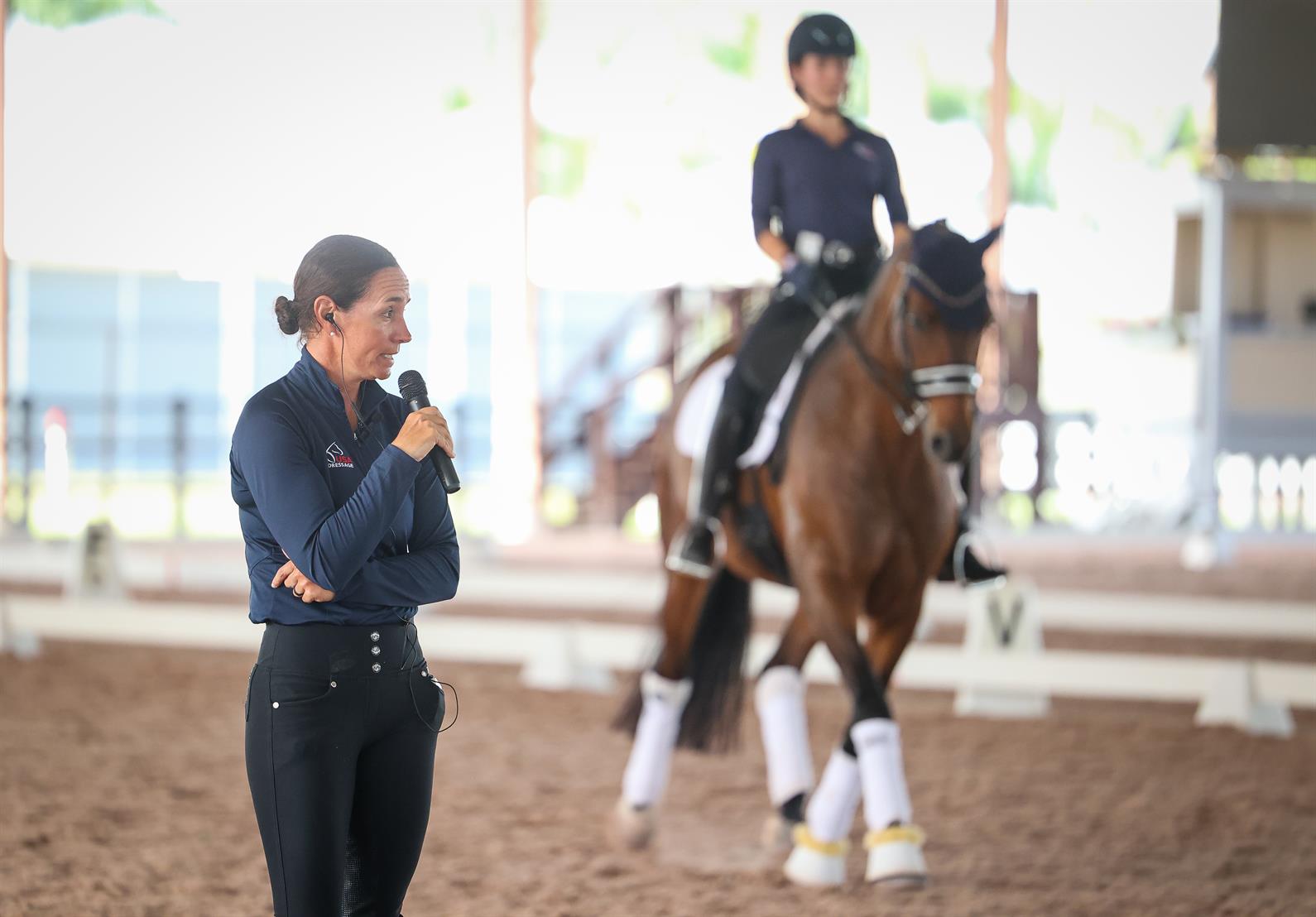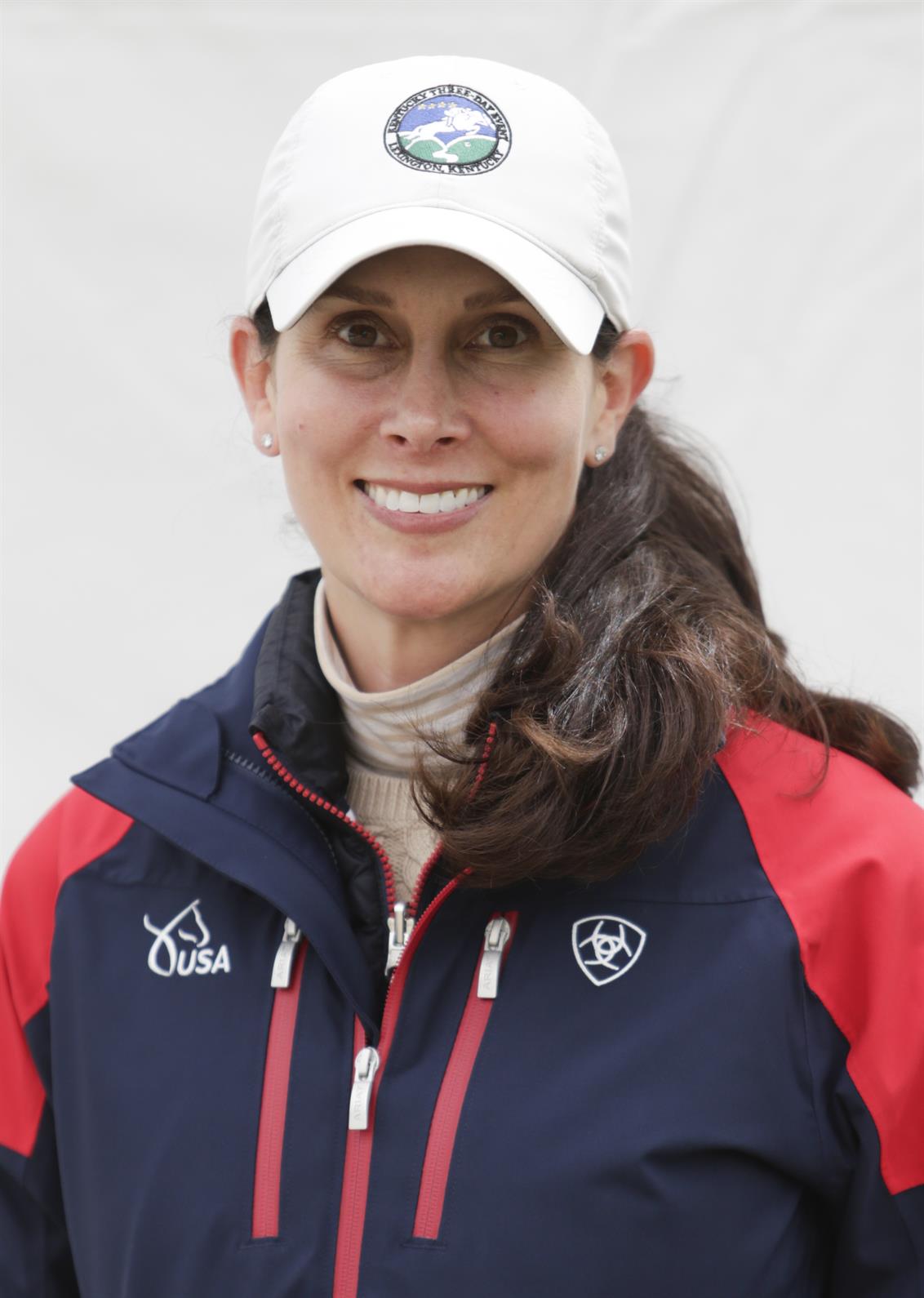Equestrian sport requires a close partnership between horse and rider, but achieving success in equestrian competition—especially at the highest levels—takes close teamwork from rider, trainer, and veterinarian to keep both human and equine athlete fine-tuned and ready to face the challenge of elite sport. Each has their own expertise and tools, but they must work together seamlessly with the goal of keeping horse and rider healthy, strong, and prepared.
How do all these roles come together to create a winning team at the top of equestrian sport? We spoke with three world-class experts—jumping athlete Anne Kursinski, dressage trainer Ali Brock, and Land Rover U.S. Eventing Team veterinarian Dr. Susan Johns—who revealed how human and equine management, training, and skill combine to produce top performance, and why great veterinary care, including use of Adequan i.m. when appropriate, is key in supporting athletic performance in equestrian sport.

Photo: Taylor Pence/US Equestrian
Anne Kursinski
Two-time Olympic silver medalist and Hall of Fame jumping athlete
The human and equine athletes are the core team, and the most visible ones, in equestrian competition. But every horse and rider pair has behind-the-scenes support. What are some of the support roles that are critical to the success of you and your horse?
The people behind the scenes are so important. The veterinarian, the blacksmith, the groom, the coaches—they’re really like the people in a race car’s pit crew. And then there are also the horse owners, who are so important. All of these roles are very important to the competitive horse and rider.
How important is your veterinarian as a member of your support team?
Your veterinarian really knows your horse inside and out, and they can give you advice both on soundness and on improving performance through veterinary care. They’re on top of your horse’s condition all the time. They know when your horse might need some vet work and can plan for things like injections to support your horse’s joints or acupuncture or things like that. But many times they also will say, “Your horse is great and doesn’t need any vet work.” These horses are elite athletes, and I think today in the sport, veterinarians are a huge factor in showing and competing horses.
What mission-critical contribution does your veterinarian play in your training and competition program? Do they sometimes help you see options for care that you might not even have known about?
Absolutely. I’ll often go to my veterinarian with an issue—say a horse is having trouble with his lead changes or doesn’t seem to be jumping as clean and carefully as he had been—and ask whether they might be able to look into that. They can go over the horse and might find, for example, that his back is sore or other simple issues that you, as the rider, might not be seeing. To have another pair of hands and eyes—and highly educated hands and eyes—can really help identify things even before they become problems.
How does your veterinarian and the use of Adequan i.m. support your partnership with your horse and contribute to your training and competition success?
Having a top veterinarian gives me huge mental confidence; it’s about knowing I have someone in my corner who really does know my horses intimately and has options like Adequan i.m. that can keep them comfortable and performing as athletes.
Horses are always trying to tell us things, whether they’re happy or unhappy about something. Maybe they’re a little more uptight or maybe they’re a little crooked or quicker at the jump or a little flatter at the jump. They won’t necessarily be lame, but they have some little difference. The vet can discover why a horse is uptight by putting their hands on a horse, watching them move, doing some flexion tests. And then they can help you fix the issue, and that’s like, “Oh my gosh, this horse is so much better because we gave injections for his joints.”
Subtle changes can be huge, and the veterinarian can very often shine a light on them and suggest something to try. This is critical to top performance today. (See Indications and Important Safety Information for Adequan i.m. in the Brief Summary below.)
What steps do you, as a rider, take to build trust and relationship with your horse?
To me, it’s really about spending lots of time with them. It’s tough today because people compete and show so much on the road, but I always like being hands-on. I don’t always have time to, say, groom them all myself, but being in the barn with the horses and watching them in the stall and in turnout, being there as often as I can when the vet or the blacksmith is there—all of that helps to build trust.
I also love flat work. I’m a big believer in basic dressage, because it promotes communication with the horses. I can see that they’re understanding my aids, and, whether it’s a hot thoroughbred or a warmblood stallion, I’m getting to know their temperament and their reaction to my aids. When I ride, I’m not just telling the horse what to do but having a real, two-way conversation. There is a lot of listening to what the horse is telling me, whether they’re feeling fit and amazing and wonderful or could use a little more flat work or a little more galloping. I always try to put myself in the horse’s shoes when I’m riding or even when I’m watching them in the stall or on the cross-ties, and I like to take time to cool them out myself after I’ve ridden. What are they feeling? That’s what I always want to know.
In your view, what are some of the keys to building a successful partnership with a horse?
Good communication is important, for sure. There also needs to be discipline and mutual respect. I really respect my horses and what they can do, how they jump or handle pressure, all of those things. And I ask them to respect me, as well, through things like doing that basic dressage to ensure rideability—because rideability is so much of show jumping today. It’s not just about the height of the jumps and the speed, but about the ability to handle such technical questions. And that rideability in a horse is totally about communication. With the great horses and riders, it's almost imperceptible how they are communicating; the horse and rider become almost like one, a little more Zen, whether it’s in jumping or eventing or dressage.
How important are partnership and trust—both between horse and rider and between rider and support team—to your training and competition plan?
The whole team is extremely important. Going into a big show or a championship, it’s crucial that you have a team you can rely on and trust. It’s important that you’ve worked together enough that they understand your idiosyncrasies, what the horse needs and what you as the rider need. On the day of competition, when everyone is working together as a team, it really is fabulous how things come together. Everybody is there to get the best out of the horses. Everybody has to leave their egos at the door and help the horse and rider perform their best.
What do you feel you and your horse gain from the competition experience? And how does it solidify your partnership?
I love to compete. To me, it’s kind of a test to see whether you have done your homework, how well you ride, how prepared your horse is to jump high or fast or careful. And sometimes, if you have a young horse that you hope may go to the Olympics someday, maybe you’re raising the competition and doing a little more each time, and you’re seeing if that horse will rise to each new challenge. These are all tests for you, for your horse, and for your team in learning how to deal with competition. It just solidifies the whole partnership.

coaches Sydney Lipar at the Robert Dover Horsemastership Clinic.
Photo: Taylor Pence/US Equestrian
Ali Brock
Olympic bronze medalist and dressage trainer
The horse and rider partnership is a close one, but the trainer plays a role in that partnership, too. How do you define your role in that partnership that rider and horse build?
I do my best to understand the horse and the rider first as individuals and then as a team, and my job is to guide them both in a way that leaves them both feeling confident and secure.
What two or three words or activities define your role in the larger team that helps prepare the horse and rider combination for competition?
Planning, preparation, and steadiness.
How does competition test the partnership of horse and rider?
Competition is important because it puts the combination under a series of conditions that can be stressful. It really shows who is able to deliver in the moment and who isn’t prepared enough. For me, it always highlights what I need to pay more attention to in my daily training and gives me direction.
What steps can you, as a trainer, take to prepare the horse and rider for the test of competition?
Everyone has to start somewhere, and I think the most important thing is to not overface the horses and the riders. They should start where they belong and advance as they are ready, so that if and when they get to the place of international sport, they are well prepared for it.
What do you consider the most important elements that a horse and rider need as they move from training to competition?
In my sport, it is about the clear and immediate communication and focus of both the horse and rider on each other. I think people get caught up in focusing on the outside parts of a competition that they can’t control versus the inner parts (themselves) that they can control. Ultimately, the rider is responsible for giving the horse the ride they need to help them listen and be secure in a new and often stressful environment.
And what can you, as their trainer, do to help them develop those elements?
I try to teach my riders to help their horses seek out the right answers.
How do veterinarians and the use of Adequan i.m. support your mission in training a horse and rider and in their success in competition?
I have used Adequan i.m. for joint support for as long as it’s been available. Joint health is imperative in keeping our horses sound and comfortable, and our philosophy is to try to not let the horse’s soundness get into a hole that we have to dig them out of. Adequan is a big contributor to keeping them in condition to help prevent a major or minor lameness episode, which is disruptive to any competition plan. (See Indications and Important Safety Information for Adequan i.m. in the Brief Summary below.)
Our veterinarian is a very important part of our team, and we rely on her heavily to help navigate our horses’ current soundness and long-term health. Her depth of experience is literally priceless.
For all of us in high-performance sport, it is imperative to have excellent veterinary care.
Our horses are top athletes and are cared for as such, just as you would care and manage a top human athlete’s training and physical and emotional health.
What do you think horse and rider gain from the experience of competition?
If it goes well, the riders and horses look to each other and enjoy it, usually because the communication and trust is strong. If it doesn’t, it’s on the rider and trainer to examine what they need to do better to set the horse up to succeed.
How do you partner with the rider and veterinarian to help ensure a horse’s optimal health and mobility during training and competition?
My vet and my farrier are both an integral part to keeping my horses sound and comfortable, and I think open and respectful communication between all of us is key.

Dr. Susan Johns
Land Rover U.S. Eventing Team veterinarian
How does your role as a sport horse veterinarian fit in on the support team that helps a horse and rider train and compete successfully?
As an equine sports medicine veterinarian, I focus on maintaining the horse’s overall health, addressing musculoskeletal issues, and optimizing performance. By providing regular evaluations, preventative care, and treatments, I contribute to the horse’s well-being allowing the rider to focus on their job at hand.
How does Adequan i.m. help you support a horse and rider in training and competition?
Adequan i.m. helps manage degenerative joint disease by promoting joint fluid synthesis, repairing cartilage, and reducing inflammation. By improving joint health, Adequan i.m. can enhance the horse’s comfort, mobility, and overall performance. Additionally, consistent training without interruptions due to joint-related issues can contribute to the horse’s overall progress and development. The preservation of joint health through Adequan i.m. therapy allows both the rider to maintain a trusted equine partner and the horse to extend its participation in training and competition.
Can you describe some of the state-of-the-art care sport horses can access now?
Sport horses now have access to advanced diagnostic imaging techniques like MRI and CT/PET scans, regenerative therapies such as stem cell and platelet-rich-plasma treatments, state-of-the-art surgical procedures, and highly specialized rehabilitation programs. These advancements enable precise diagnoses, targeted treatments, and comprehensive rehabilitation plans, leading to optimal recovery and performance.
How do these kinds of treatments benefit the horse and improve equine athletes’ well-being overall?
These advanced treatments offer numerous benefits to horses and improve their overall health. They aid in faster and more accurate diagnoses, facilitate targeted and effective treatments, expedite recovery from injuries, and minimize downtime. By optimizing their health and addressing issues promptly, these therapies enhance the horse’s athletic potential, reduce discomfort, and contribute to their longevity in their discipline.
In addition to modern treatments and technology, what are some best practices you recommend to riders and trainers to help keep a horse fit, happy, and performing at its best?
To keep a horse fit, happy, and performing at its best, I recommend regular exercise tailored to each horse’s needs, appropriate nutrition, routine preventative care, proper hoof management, maintaining a suitable environment, thoughtful conditioning programs, and allowing adequate rest and recovery. Regular communication and collaboration with the entire support team are also key in maintaining the horse’s overall wellness.
Can you describe your own emotions and thoughts when a horse and rider you support as a veterinarian are successful in competition?
As a veterinarian supporting a horse and rider in competition, witnessing their success is always a gratifying experience. It is a testament to the collective efforts of the entire support team. Knowing that I played a part in enhancing their health and well-being brings a great sense of fulfillment and pride. It reinforces my commitment to providing top-quality care and fuels my dedication for supporting equine athletes.
Adequan® i.m. (polysulfated glycosaminoglycan)
BRIEF SUMMARY: Prior to use please consult the product insert, a summary of
which follows: CAUTION: Federal law restricts this drug to use by or on the order
of a licensed veterinarian. INDICATIONS: Adequan® i.m. is recommended for the
intramuscular treatment of non-infectious degenerative and/or traumatic joint
dysfunction and associated lameness of the carpal and hock joints in horses.
CONTRAINDICATIONS: There are no known contraindications to the use of
intramuscular Polysulfated Glycosaminoglycan. WARNINGS: Do not use in horses
intended for human consumption. Not for use in humans. Keep this and all
medications out of the reach of children. PRECAUTIONS: The safe use of
Adequan® i.m. in horses used for breeding purposes, during pregnancy, or in lactating
mares has not been evaluated. For customer care, or to obtain product information,
visit www.adequan.com. To report an adverse event please contact American Regent,
Inc. at 1-888-354-4857 or email pv@americanregent.com.
PP-AI-US-1048


